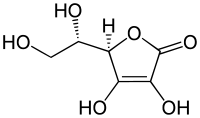
Photo from wikipedia
The work describes the carotenoid synthesis process by Rhodotorula glutinis P4M422 using an agro-industrial waste as the substrate, seeking a biorefinery platform approach for waste utilization to produce high-value molecules.… Click to show full abstract
The work describes the carotenoid synthesis process by Rhodotorula glutinis P4M422 using an agro-industrial waste as the substrate, seeking a biorefinery platform approach for waste utilization to produce high-value molecules. A culture medium based on goat milk whey (GMW) was optimized via the Taguchi method (L9 array). Four factors (ethanol, carbon and nitrogen source, and pH) were evaluated at three levels. The carbon and nitrogen composition were the factors dominating the process performance. Optimized conditions were validated (Urea, 0.3% w/v; pH, 4.5; ethanol, 10% v/v; glucose, 6.0%), and the carotenoid production (4075 µg/L) was almost 200% higher than when using the un-optimized process (2058 µg/L). Provitamin A carotenoids torulene, β–carotene, and γ–carotene (different proportions) were produced under all conditions. The hydrolyzed goat milk whey showed promising expectations as a low-cost source for carotenoid production by Rhodotorula glutinis P4M422. The results are important for the innovative sustainable production of carotenoid-rich matrices for different purposes (nutrition, health promotion, color) and industries (foods, nutricosmetics, nutraceuticals, feeds), notably to help to combat vitamin A deficiency.
Journal Title: Foods
Year Published: 2023
Link to full text (if available)
Share on Social Media: Sign Up to like & get
recommendations!